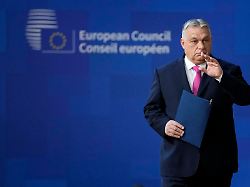No more veto for Orban
EU is coming up with Plan B for aid to Ukraine
December 27, 2023, 10:19 a.m
Listen to article
This audio version was artificially generated. More info | Send feedback
Ukraine needs money to pay wages and pensions and to run hospitals, schools and emergency shelters. 26 EU states would like to transfer billions of euros to her, but Hungary is standing in the way. A well-known model would circumvent the Hungarian veto.
The European Union is preparing a new aid program for Ukraine worth up to 20 billion euros, in which Hungary will have no say. If Hungarian Prime Minister Viktor Orban maintains his veto at the upcoming EU summit on February 1, the debt-financed plan would bypass Hungary in order to quickly release the money, reported the Financial Times. The model therefore envisages that the remaining 26 EU states provide guarantees for the EU budget, which would enable the European Commission to borrow up to 20 billion euros on the capital markets for Ukraine in the coming year.
According to insiders, the exact terms of the contract and the amount of aid are still being negotiated. It is said that the final amount of the aid loans should depend on Ukrainian needs. However, the procedure is already known: In the same way, the EU Commission raised almost 100 billion euros on the capital markets in 2020 to support the EU states in the Corona crisis.
Bundestag must agree
The EU has been trying unsuccessfully for weeks to put together a financial package worth 50 billion euros for Ukraine over the next four years. 17 billion euros of this will flow as grants and 33 billion euros as loans. However, all 27 EU states must agree to this plan, which Orban blocks: “Veto against the additional funds for Ukraine,” said the Hungarian head of government two weeks ago after the last EU summit in Brussels.
Using the new model, Orban would no longer be able to block aid to Ukraine. However, support would have to be approved by parliaments in several countries, including Germany. According to the “Financial Times”, insiders hope that this step can be completed so that the aid can be transferred by March at the latest.
Money for pensions, wages and infrastructure
The EU wants to use the financial aid to enable the Ukrainian state to pay wages and pensions. In addition, the operation of hospitals, schools and emergency accommodation for resettled people should be guaranteed. The money can also be used to repair and rebuild infrastructure destroyed by the Russian war of aggression. These include power lines, water systems as well as roads and bridges.
For this reason, in 2023 the EU transferred a total of 18 billion euros to Kiev. Despite the ongoing war, the payment is linked to 20 reform commitments and reporting obligations. For example, they are concerned with the rule of law and the fight against corruption. Ukraine has up to 35 years to repay the money, which is scheduled to begin in 2033. The interest costs are borne by the EU member states.
